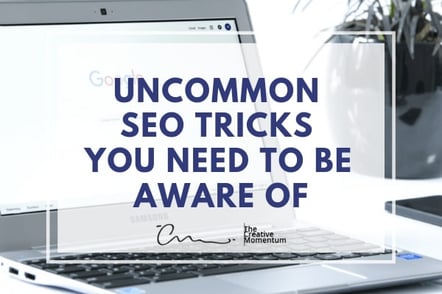
There’s nothing wrong with the tried-and-true SEO tactics we grew up on. Link-building, long-tailed keyword focus, and quality content are as relevant today as they ever were, but these basic strategies aren’t the only tools in the SEO marketer’s arsenal. Below, we’d like to review a few uncommon-yet-important SEO tactics that you might not be aware of.
1. Pillar Page Organization
Two things right off the bat:
- Pillar pages are quickly shifting from “uncommon” to “best practices” territory;
- Pillar pages aren’t an SEO “trick” as much as a more sophisticated style of web design.
With these disclaimers in mind, let us press onward. Pillar page organization may be the single best improvement you make to your website SEO, particularly for websites with extensive content libraries. Here’s how they work.
Pillar pages are content pages that contain information and links to every blog you have on a particular topic. For example, you might have 30 blogs on content marketing in your library, each loosely connected with category tags. With pillar pages, you’d create a single topic page for content marketing that offers an overview of the topic as well as links to each of your 30 in-depth pieces.
The concept is commonly likened to a spoked wheel. The pillar page is the wheel “hub,” with linked blogs acting as the spokes. From an SEO standpoint, this is a powerful way to give crawlers more information about your page.
It’s known that web crawlers give SEO value to pages with clear navigational hierarchies; the more context a crawler has for each page, the better it will understand it, and the more able it’ll be to deliver that content to searchers. When you use pillar pages, you’re linking all of your content together in a way that’s favored by search engines, giving you an edge over those still stuck with disconnected content libraries. Plus, the pillar page itself works great as a landing page for users, with plenty of space for keyword inclusion in the content.
2. Leverage Sharable Images
When marketers think of backlinks, they tend to imagine direct links to the blog itself, usually embedded as a text hyperlink a different blog’s content. But this is only one type of backlink. To boost your SEO ranking, you can take advantage of another kind: image backlinks.
Every time someone uses an embed code to share an image you have in one of your pieces, the image will link back to your page. You can tap into this by working on your content’s visuals:
- Make sure to include relevant images in every piece
- Diversify images by including infographics, charts, graphs, and other data-centric materials that others can repurpose
- Use a tool to generate embed codes for each image and make the code easy for readers to find.
3. Prepare for Voice Queries
If you haven’t prepared for voice searches and the impact they’re having on SEO, it’s time to start.
It’s clear that consumers enjoy the convenience of voice searching, and the proliferation of personal assistant apps has spiked its use even further. According to 2018 research from PwC, 32 percent of consumers surveyed used daily voice searches to find information they’d otherwise type into search engines.
Take a look at your traffic and see what kind of keyword phrases are bringing people to your pages. Generally, voice searches tend to be long-tailed keyword queries in the form of a question or basic keyword phrase: “What’s the highest-rated restaurant near me?” or “Best restaurants near me.” By tweaking your keyword strategy to accommodate these voice-based queries, your page will be more relevant (and ranked higher) for your voice users.
4. Robots Exclusion Protocol
This one’s simple: include the Robots Exclusion Protocol (robots.txt) in your sitemap. This is a simple text file that gives instructions to web crawlers when they visit your site, telling them which pages should be indexed and which should be ignored. This can be particularly helpful for larger sites with thousands of pages.
Google’s SEO algorithm penalizes sites that have too many irrelevant pages indexed. Duplicate content, zombie pages, and other low-value resources can all detract from your website’s SEO ranking. Adding this exclusion protocol will stop web crawlers from indexing your low-value pages and help them stick to the pages you’ve optimized.
5. Keep NAP Information Consistent
If you’re promoting a brick-and-mortar store alongside your online presence, you likely know the importance of local SEO already. But make sure you’re keeping your information up-to-date! It’s fine to use Google My Business or Bing Places for Business, but you’d be surprised at how many business owners fail to keep their NAP (Name, Address, Phone) up-to-date. Just look up a few businesses and you’ll notice some discrepancies for yourself, such as companies that have moved to a new location or changed operating hours without updating their online listings.
Web crawlers prioritize information that is consistent across platforms and resources, particularly when displaying geo-targeted results for local searches. If you’re going to the trouble of using these tools, do the algorithms (and your customers) a favor by keeping things up-to-date.
6. Optimize Video Content
Video content is an inseparable part of your marketing strategy, but for maximum SEO value, you’ll need to make sure it’s optimized to appear in video search results.
Go through your content library and review each video. Like you do for the rest of your content, make sure each video is optimized with the correct titles, meta descriptions, tags, and keywords. This is the basic structure for SEO value, but don’t stop there. You should also consider including a transcript of the video on your site. This is great for your hearing-impaired viewers, but on top of that, the additional text gives web crawlers more data to scrape.
While you’re at it, make sure the thumbnail is optimized with an interested screencap. Don’t let the video automatically choose one! Research by video platform Wistia found that videos with human-selected thumbnails received 30 percent more plays than those without.
Getting Creative With Website SEO
With how much secrecy there is around search engine ranking signals, it’s understandable that so many companies would be leery about deviating from time-tested practices. But we’re here to tell you that you shouldn’t be afraid of your SEO! The companies sitting at the top of the SERPs didn’t get there by following established trends; they tried new strategies and explored creative approaches that eventually produced results. Take the same fearless approach to your own SEO strategy and give one of these uncommon tactics a try.


